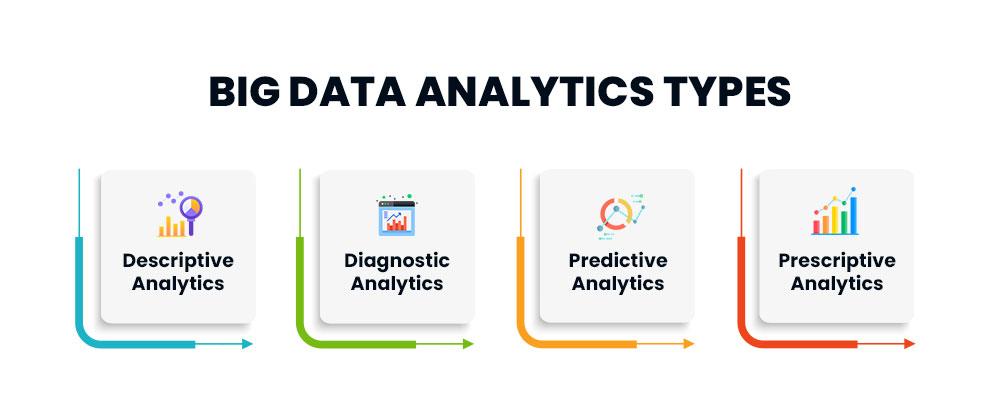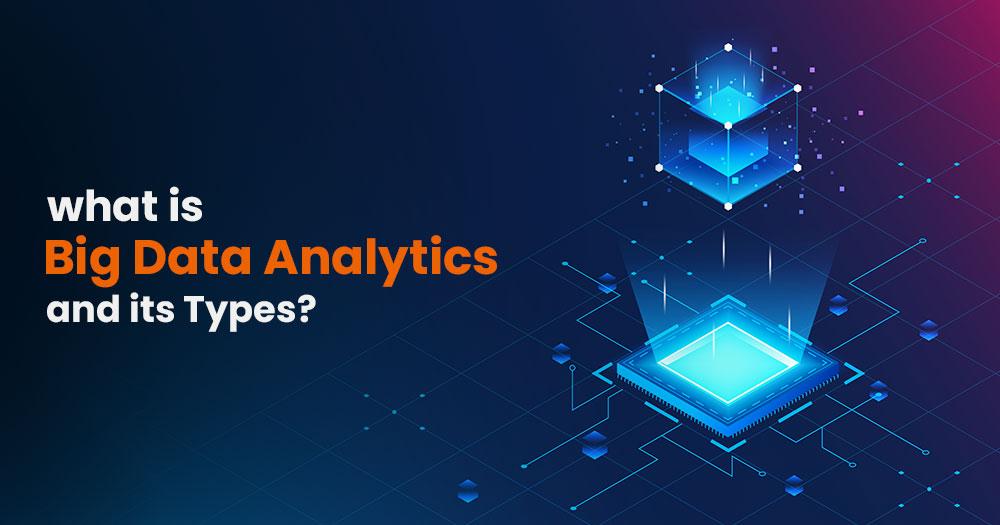What is Big Data Analytics?
The concept of big data analytics has been around for years; many organizations now understand that if they keep capturing all the data that streams into their businesses (potentially in real-time), they can apply big data analytics and get significant value from it. This is particularly true when using sophisticated techniques like artificial intelligence. But even in the 1950s, decades before anyone uttered the term “big data analytics,” businesses were using basic data analytics (essentially, manually examined numbers in a spreadsheet) to uncover insights and trends.
Why big data analytics is important?
Big data analytics assists organizations harness their data to identify new opportunities. That, in turn, leads to intelligent business moves, more efficient operations, high profits, and happy customers. Businesses that use big data analytics with advanced analytics gain value in many ways, such as:
Minimum cost. Big data analytics technologies like cloud-based analytics can vastly reduce costs when storing large amounts of data (for example, a data lake). Plus, it assists organizations find more efficient business ways.
Making faster, better decisions. The speed of in-memory analytics – combined with the ability to analyze new data sources, such as streaming data from IoT – assists businesses in analyzing information immediately and making faster, informed decisions.
Developing and marketing new products and services in big data analytics. Gauging customer requirements and satisfaction through big data analytics empower businesses to give customers what they want when they want it. With this, more companies have an opportunity to develop innovative new products to meet customers’ changing requirements.
Types of Big data analytics

Descriptive Analytics
Descriptive Analytics is considered a helpful technique for uncovering patterns within a particular segment of customers. It simplifies the data and summarizes past data into a readable form.
Descriptive analytics provide insights into what has occurred in the past and trends to dig into for more detail. This helps create reports like a company’s revenue, profits, sales, etc. Examples of descriptive analytics include summary statistics, clustering, and association rules used in market basket analysis. An example of the use of descriptive analytics is the Dow Chemical Company. The company utilized its past data to increase its facility utilization across its offices and labs.
Diagnostic Analytics
Big data analytics types Diagnostic Analytics, as the name gives a diagnosis to a problem. It provides a detailed and in-depth insight into the root cause of a problem. Data scientists turn to this big data analytics crave for the reason behind a particular happening. Techniques like drill-down, data mining, data recovery, churn reason analysis, and customer health score analysis is diagnostic analytics examples. In business terms, diagnostic analytics is helpful while researching the reasons leading churn indicators and usage trends among your most loyal customers.
Usage of the case for diagnostic analytics can be an e-commerce company. Provided the situation that the company’s sales have gone down even though customers are adding products to their carts.
The possible reasons behind this problem can be:
- The form didn’t load correctly.
- The shipping charges are high.
- Not enough payment methods are available.
Taking the help of diagnostic analytics, the company comes out with a specific reason and then works on that to resolve the issue.
Predictive Analytics
This big data analytic type, Predictive Analytics, as can be discerned from the name itself, is concerned with predicting future incidents. These future incidents can be market trends, consumer trends, and many such market-related events.
This type of analytics uses historical and present data to predict future events. This is the most commonly used form of analytics among businesses.
Predictive analytics doesn’t only work for the service providers but also for the consumers. It keeps track of our past activities and predicts what we may do next based on them. Predictive analytics uses the models like data mining, AI, and machine learning for analyzing current data and forecasting what might happen in particular scenarios.
Prescriptive Analytics
This big data analytics type of Prescriptive analytics is the most valuable yet underused form of big data analytics. It is the next step in predictive analytics. The prescriptive analysis explores several possible actions and suggests actions depending on the results of descriptive and predictive analytics of a given dataset.
Prescriptive analytics is a combination of data and various business rules. The data of prescriptive analytics can be both internal (organizational inputs) and external (social media insights). Prescriptive analytics allows businesses to determine the best possible solution to a problem. Combined with predictive analytics, it adds the benefit of manipulating a future occurrence, like mitigating future risk.
Examples of prescriptive analytics for customer retention are the next best action and next best offer analysis. A use case of prescriptive analytics can be the Aurora Health Care system. It saved $6 million by reducing the readmission rates by 10%.
Prescriptive analytics has good use in the healthcare industry. Can use it to enhance drug development, find the right patients for clinical trials, etc.
Big data analytics companies
Rapids
Rapidops Inc. is a technology, transformation, and big data analytics company. It assists clients design, engineering, and launching advanced digital products and platforms that enable them to thrive and achieve more for their customers. Since 2008, their team has delivered thousands of projects and digital products, touching millions of lives daily, solving tough problems, and changing how people live, work, and engage. Rapids operates in the retail, manufacturing, supply chain, healthcare, and technology industries. They work with companies like Dassault Systems, Kroger, Harris Teeter, BigCommerce, and Tresata. They have also launched digital platforms like Salesmate.io, used by thousands of businesses across the globe.
Reonomy
Reonomy is the leading provider of CRE insights, empowering top brokerages, financial institutions, and commercial services providers with actionable data and solutions.
Armed with Reonomy’s enterprise-grade products, CRE professionals and organizations gain comprehensive market understanding, discover opportunities, and streamline research processes. Reonomy’s proprietary data pipeline puts actionable information about properties, owners, occupants, and lenders at your fingertips. By cleansing and augmenting your commercial real estate data, our solutions help strengthen your organization’s infrastructural backbone with Reonomy.
SAP
SAP is a German multinational software corporation based in Walldorf, Baden-Württemberg, that develops enterprise software to manage business operations and customer relations. The company is especially known for its ERP software. SAP is the largest non-American software company by revenue, the world’s third-largest publicly-traded software company by revenue, and the largest German company by market capitalization. Since 2012, SAP has acquired several companies that sell cloud-based products, with several multibillion-dollar acquisitions seen by analysts as an attempt to challenge competitor Oracle. In 2016 SAP bought Concur Technologies, a cloud-based travel and expense management software provider, for US$8.3 billion, SAP’s most expensive purchase to that date. Analysts’ reactions to the purchase were mixed, with Thomas Becker of Commerzbank questioning whether Concur was the right choice for SAP, while Credit Suisse called the acquisition an “aggressive” move.
Sedin Technologies
Sedin is an IT consulting, system integrator, and software services company. Since 2006, they have been delivering business solutions by leveraging domain expertise and cutting-edge technologies for our clients ranging from stratus to enterprises. Sedin Technology’s R&D team is constantly working on building innovative products and efficient solutions with an approach to adding business value and accelerating the ROI for our clients.
Sisense
Sisense, has the vision to drive a meaningful change in the world to make it easy for businesses to infuse analytics everywhere. This big data analytics company Sisense goes beyond the dashboard by giving an AI-driven platform that any company can use to drive better, fast decisions for their business and customers.
More than 2,000 global companies such as GitLab, UiPath, Tinder, Nasdaq, GE, Rolls Royce, and Philips Healthcare rely on big data analytics company Sisense to innovate, disrupt markets, disrupt markets, and drive meaningful change in the world. Ranked as the No. 1 Business Intelligence company in customer success, Sisense has also been named one of Forbes’ Cloud 100, The World’s Best Cloud Companies, five years in a row.
Big data analytics applications
Here is the list of industries using big data analytics applications:
- Banking and Securities
- Communications, Media, and Entertainment
- Healthcare Providers
- Education
- Manufacturing and Natural Resources
- Government
- Insurance
- Retail and Wholesale trade



The blog presented on Big Data Analytics starts a presentation of contents with history and evolution of big data analytics giving a brief into the contemplation till new era. Further describing the importance in our generation and opportunities ahead. It very easily describes the four types in a short depictive manner which gives the reader interesting insights ahead too.
Lastly the analytics company and the application mentioned is a cherry on the top as this adds a surplus knowledge to the string.
According to me it is beneficial for the readers, studying about described topic for the first time in a very comprehended language.
The blog post on big data analytics begins with a presentation of its history and development, providing a quick look into its development up until the modern day. a description of the significance to our generation and the opportunities that lie ahead. It succinctly and clearly illustrates the four types while also providing the reader with intriguing insights into the future.
The indicated analytics company and programme are the icing on top because they offer further knowledge to the string.
For the readers, it is advantageous, in my opinion, to learn about the subject matter provided for the first time in a highly understandable language.
The blog presented on big Data Analytics starts a donation of contents with history and elaboration of big data analytics giving a detail into the contemplation till new period. farther describing the significance in our generation and openings ahead. It veritably fluently describes the four types in a short depictive manner which gives the anthology intriguing perceptivity ahead too.
Incipiently the analytics company and the operation mentioned is a cherry on the top as this adds a supernumerary knowledge to the string.
According to me it’s salutary for the compendiums , studying about described content for the first time in a veritably comprehended language.
The blog stated in Big Data Analytics offers insights into the new era, starting with offering content that includes details about the history and nature of Big Data Analytics. Give further information about the implications for our time and the future. The anthology covers the four categories in a highly fluid, short, and descriptive way, which gives it an intriguing perceptive potential.
Since they provide the chain with more information, the operations and analytics company is originally the icing on the cake.
I think it’s beneficial to learn about topics for compendiums for the first time in a very understandable way.
This article is quite informative. Helped me break the ice with the idea of big data analytics, its basics and its several types.
Such a complicated topic boiled down to such easy explanation. Precaution: Reading too much on this site can make you topper🫡🫡
This is truly informative!
Following Brainalyst right away to get updates of some more amazing, informational, intellectual writeups likw tgis one. The go to place for all the data enthusiasts out there and a chance for everyone to shape their career!!
This is such an amazingly written blog considering it covers everything you need to know! Very helpful
Brainalyst and its blogs really becoming the literal guide for all the keen learners out there. Nicely written. Keep up the good work!